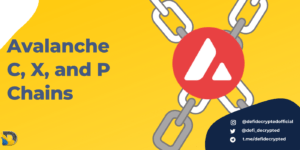Avalanche network is an open-source blockchain platform that supports smart contract functionality. It focuses on scalability for faster transactions, low fees and environmental-friendliness. Avalanche is built to be dynamic and interoperable with other platforms and has a native token, AVAX.
According to the crypto tracker, CoinMarketCap, AVAX ranks ninth-largest cryptocurrency by market cap, as of February 18, 2022, at over $21 billion. (Note that crypto markets are highly volatile and figures may change)
Avalanche quickly rose to be among the top-ranking projects in a very short period. This is thanks to its revolutionary features that have attracted developers and users to its platform.
This guide will explain everything you should know about Avalanche, including how it works and what the AVAX token does. Lets jump in!
Avalanche Developers
Avalanche was launched by Ava Labs – an institution founded by Cornell University professor Emin Gun Sirer, Cornell University computer science Ph.D. Kevin Seknigi, and Maofan “Ted” Yin. These founders have been previously involved in researching scaling solutions for Bitcoin and other blockchains.
How Avalanche Differs from Bitcoin
Avalanche and Bitcoin’s operations stark contrast lies on their consensus mechanisms. Unlike Bitcoin’s Proof-of-Work, Avalanche deploys an innovative mechanism for optimizing the speed, scalability, flexibility of transactions. To illustrate, Bitcoin can process about seven transactions per second (tps) while Avalanche can handle up to 6500 tps.
How Avalanche Works
As a layer-1 blockchain, Avalanche sets to resolve inherent issues in older blockchain protocols like high energy demands and limited scalability. Avalanche rivals other popular smart contract blockchains like Ethereum and Binance Smart Chain (BSC). The platform offers higher transaction throughput – up to 6,500 tps, among other unique features.
Since its mainnet launch in 2020, Avalanche has sped up the development of decentralized applications (DApps) and other decentralized finance (DeFi) protocols on its platform. The blockchain focuses on bridging its ecosystem with other smart contract blockchains, like Ethereum. This allows for seamless interoperability across different blockchains.
But how does Avalanche really work to achieve all this?
A Three-blockchain Architecture
To tackle issues related to scalability, usability, and interoperability, Avalanche deploys an innovative infrastructure comprising three different blockchains.

X, C and P Chains on Avalanche
Each of the three blockchains is designed to exclusively operate on a specific task on the Avalanche ecosystem. This innovation enables the blockchain to process tasks more efficiently. As such, Avalanche boasts of a 1-second time-to-finality (that is, the time after a crypto transaction is considered final and immutable). This record time for transaction finality is arguably the shortest in all blockchains. In comparison, Ethereum’s transaction finality is about 1 minute.
Here’s a closer look at the three individual blockchains making up the Avalanche mainnet:
i. X-Chain
The Exchange Chain (X-Chain) is Avalanche’s blockchain tasked to create, transact, and manage Avalanche assets, including its native token, AVAX. Other popular assets managed by X-Chain on Avalanche include decentralized exchange (DEX) tokens, Trader Joe (JOE), and Pangolin (PNG).
Each transaction on the X-Chain, regardless of the token used in the transaction, is settled with fees in Avalanche’s AVAX. X-Chain deploys the Avalanche consensus protocol and tokens managed in the blockchain follow its standardized protocol.
ii. C-Chain
The Contract Chain (C-Chain) is the blockchain tasked to create and host smart contracts and DApps. C-Chain runs Avalanche’s smart contracts via the Avalanche Virtual Machine, which is compatible with the Ethereum Virtual Machine (EVM).
This EVM compatibility allows developers to deploy Ethereum smart contracts on Avalanche, to leverage the blockchain’s scalability and security features. Since developers can fork EVM-compatible DApps on Avalanche, more projects have seamlessly deployed a version of their products on the faster, cost-effective blockchain. C-Chain uses the Snowman consensus mechanism for its operations.
iii. P-Chain
The Platform Chain (P-Chain) works to coordinate network validators, track active subnets – a group of validators, and enable the creation of new subnets. Although subnets can create their rules for operations on a specific blockchain, each of these subnets can only validate their blockchain and the Primary Network chain. To participate in validating the Primary Network, a subnet must be a Primary Network member by staking at least 2,000 AVAX tokens.
So, the P-Chain allows users to create Layer-1 or Layer-2 blockchain solutions using these subnets, with P-Chain as the default subnet. P-Chain also deploys the Snowman consensus protocol for its operations.
Consensus Protocols
The Avalanche consensus protocol randomly checks transaction confirmations by validators by ensuring each node on the network operates parallel to the others. These random checks ensure that transaction confirmations are valid.
The Snowman consensus protocol works similar to the Avalanche consensus protocol, only contrasting by deploying linear checks on blocks instead of the random checks. Each consensus mechanism is designed to perform optimally on the blockchain it is deployed.
Achieving Scalability in Avalanche
A subnet is a clone of the default blockchain connected to the platform. Users can create more clones, or subnets, as demanded. So, when a subnet temporarily reaches its scaling limits, users can generate another subnet to cover the traffic demands at the time and expedite transactions. Since there are no limits to creating subnets on Avalanche, the platform’s P-Chain can handle up to 4,500 tps making subnets key to achieving scalability on Avalanche.
Benefits of Avalanche Network
Scalability: Avalanche blockchain is by far ahead of the two most popular blockchains – Bitcoin and Ethereum – based on transaction throughput and transaction finality. Higher processing capacity makes for convenient and reliable DApps that can compete with centralized apps.
Interoperability: Not many blockchains support cross-chain operations, especially deployment of DApps or smart contracts across different blockchains. With EVM-compatible Avalanche, developers can launch versions of their Ethereum-based products on the Avalanche network.
Usability: Avalanche is a ready-to-use platform that users find simple to get started. Many developers do not require special skills to start building apps on Avalanche.
AVAX Token
Avalanche Ecosystem
AVAX token is Avalanche’s default utility token that serves multiple uses on the platform including:
- Settling transaction fees
- Making payments for creating custom tokens via X-Chain, launching smart contracts on C-Chain, or creating subnets.
- Staking AVAX to become validators and earn rewards. Alternatively, users can delegate their tokens to an approved validator and earn a proportion of the rewards.
Avalanche Network is a deflationary token, meaning the coin’s supply is designed to fall over time through payment of transaction fees and burning other tokens from supply. AVAX has a maximum supply cap of 720 million tokens, with over 377 million tokens currently in circulation and at least 278,000 tokens burned.
Avalanche Network Takeaway
Avalanche’s incomparable transaction speeds set the blockchain apart from the rest. The platform’s security and scalability features make it especially important in the DeFi revolution. As Avalanche continues to power the development of DApps around the world, it will become more accessible to developers and users in the fight against centralized finance.










